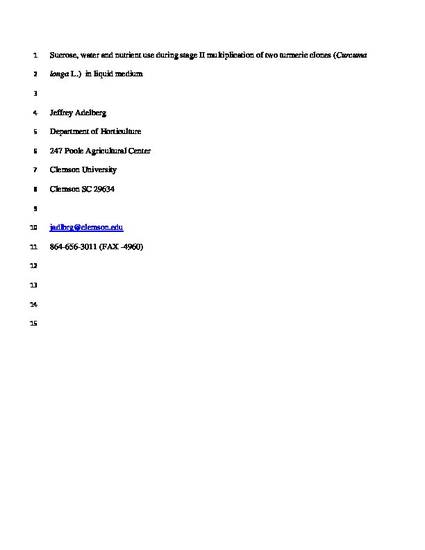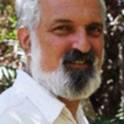
Two clones of turmeric (Cucruma longa L.) were assessed nine times during a 28-day culture period in double phosphate MS liquid medium containing 2%, 4% and 6% sucrose. The phase of rapid shoot bud multiplication lasted for 21 days or less, in both clones in all media. The maximum multiplication rate was 3.4× at 20 and 19 days, with 3.9% or 4.7% initial sucrose concentration being optimal for the clones 9-3 and 35-1, respectively. Dry mass increased over the entire culture period and was greatest with 4.8% or at least 6% initial sucrose concentration for the two clones, 9-3 and 35-1, respectively. Maximum tissue water mass required 2.8% and 3.9% initial sucrose, respectively, in the two clones. Tissue relative water content (tissue water mass/fresh mass) was better correlated with sucrose concentration in medium, than the osmolality of medium, for both clones at all sucrose concentrations. Relative water content increased over time (water was incorporated more rapidly than dry mass in growing tissue) and sucrose concentration in media decreased over time (sucrose was used at a relatively more rapid rate than water). The concentrations of 10 nutrients (P, K, S, Zn, Mg, Fe, B, Ca, Mn and Cu) and Na assayed in time course all decreased rapidly over time. The rates of nutrient use were better related to growth of plant mass than shoot bud multiplication. P and Cu were completely depleted from medium before the end of the culture period. P concentration in tissues was in the lower ranges of that considered optimal, and Cu was in excess concentrations, based on comparison to high-yielding field-grown plants. Sugar, water, and nutrient use were more closely related to plant mass than shoot multiplication. The stationary phase of bud multiplication was coincident with continued growth of tissue dry and water mass. Among inorganic nutrients, lowered concentrations of P were most likely related to the stationary phase of bud multiplication, but still permissive of dry and water mass increases. Lowered availability of sugar, other inorganic nutrients, or less available water, did not precede day 21 and the end of active shoot bud multiplication. In batch culture, the concentration of a nutrient that is rapidly used (e.g. sucrose) does not remain at an optimal range for a prolonged period of time.

This manuscript has published in the journal Scientia Horticulturae. Please find the published version here (note that a subscription may be needed to access this version): www.sciencedirect.com